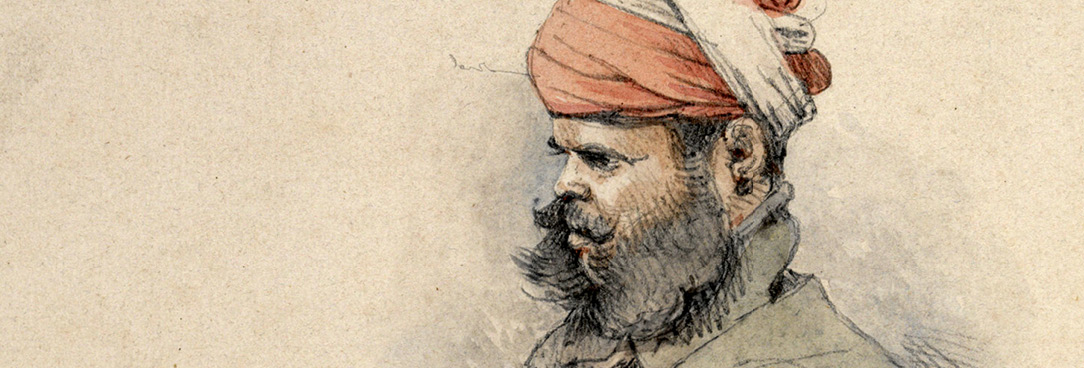Last updated:
‘What Happened to the Camels of the Burke and Wills Expedition?’, Provenance: The Journal of Public Record Office Victoria, issue no. 9, 2010. ISSN 1832-2522. Copyright © Donna Bourke.
The story of the camels that survived the expeditions of Burke and Wills is not well known. What happened to these surviving camels? Donna Bourke became intrigued by the story after discovering there was a link to the Longerenong Homestead in the Wimmera that she had purchased with Ian Pausacker.
Robert O’Hara Burke and his party set off from Royal Park in 1860 on an ill-fated expedition of discovery that took them through Australia’s interior to the northern coast at the Gulf of Carpentaria. When they failed to return in 1861, a relief expedition led by Alfred William Howitt found what was left of the party, and in 1862 Howitt set out with Alexander Aitken on a second expedition to bring the remains of Burke and William John Wills home for burial. They also brought back with them what was left of the twenty-six camels that had accompanied the expedition – those that had not been shot, left bogged or eaten for food along the way. Aitken took the camels to Samuel Wilson’s property in the Wimmera.
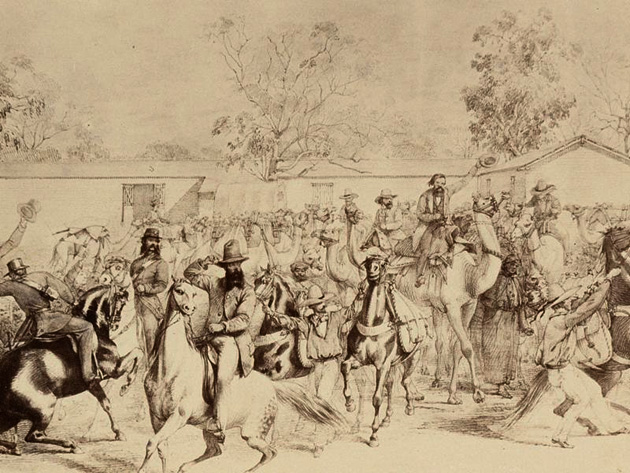
Courtesy of the Dixson Library, State Library of NSW.
Not all of the camels imported from Afghanistan and northern India were taken on Burke’s expedition. On 7 May 1861, Edward Wilson, President of the Acclimatisation Society, reported that an offer had been made by Samuel Wilson (no relation) ‘for the use of one of [his] paddocks in the Wimmera for the camels … now in Royal Park’.[1] The society recognised the offer ten days later: ‘I have the honour to acknowledge the receipt of your favour dated the 8 inst and by directions of the Council to thank you for your kind offer’,[2] but took no further action until September.

Reproduced with the permission of the Parliamentary Library, Parliament of Victoria.
Why Did the Camels Leave Royal Park?
The small herd of camels left behind at Royal Park increased to nine when Sampson, one of Howitt’s men, brought ‘one male [Nero] and four female camels’[3] to the park in March 1862. The report of Royal Park’s superintendent, delivered to the Acclimatisation Society on 8 July, records the ‘great expense of the camels’ and notes that these new arrivals had ‘increased the food bills alarmingly’.[4] The superintendent spoke at this meeting of ‘the difficulty of trying to keep them free from scab’,[5] a skin disease that afflicts woolly animals kept in damp conditions. The necessity of finding a suitable location for the camels grew more desperate as the cold, wet winter continued and the challenge of keeping these desert animals in reasonable health increased.
There were other problems too. On 12 August, there was trouble with the horses when ‘one of the camels had been driven into town … and there was a danger … of horses taking fright’.[6] Safety concerns also arose with Nero, who had mauled a sepoy named Batton near Menindee on 3 January. The camel was described as ‘vicious and ill tempered’ and had ‘frequently hunted everybody out of camp or up into trees’.[7] One Saturday night ‘lads’ were torturing the new arrivals, as reported in the minute book of the society, especially ‘the camel which had mauled its black attendant’. Nero’s torturer, George Fletcher, was sentenced to a week in prison or the payment of two shillings for abusing the camel.[8]
The Council of the Acclimatisation Society eventually accepted the offer from Samuel Wilson, five months after it had originally been made, observing that there was ‘no immediate use for the camels … as the climate is … too damp and cold for their permanent health’. The Council only needed ‘to confirm the arrangement’ at the meeting of 30 September 1862 ‘with the receipt of Mr. Samuel Wilson’s letter’.[9]
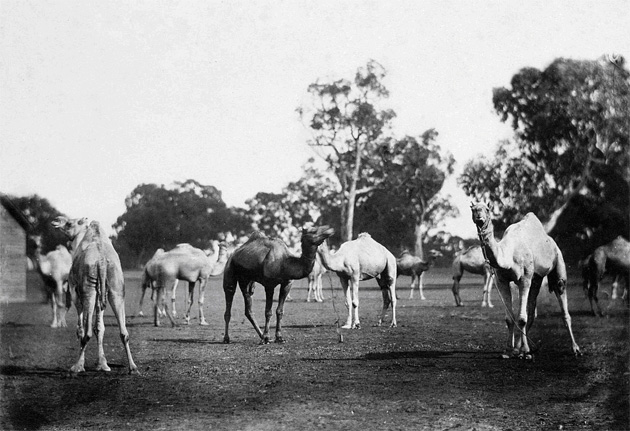
Courtesy of the Dixson Library, State Library of NSW.
Samuel Wilson’s Interest in the Royal Park Camels
In the early 1860s, the seasons were bountiful. There was no shortage of pasture and it was a bumper year for the price of wool. At this time, Samuel Wilson had an income of ‘£20,000 per annum’[10] and the land, pasture and discretionary income for experimenting with camels. Indeed, his land holdings were extensive: Longerenong Station was 153,000 acres (in conjunction with his brothers Charles and Alexander, who lived on adjoining stations, and another brother John, his pastoral holdings in Wilson Brothers included 742,000 acres in the Wimmera alone)[11] and provided plenty of space in a dry climate for a paddock for the camels.
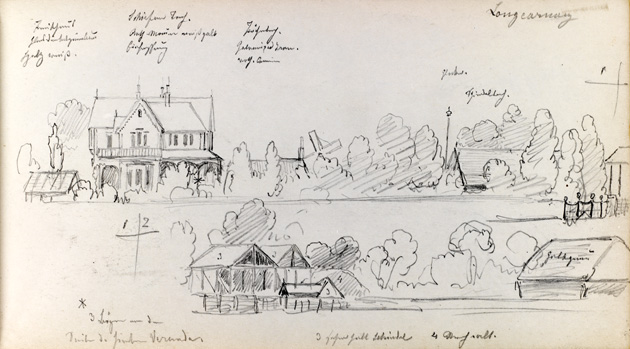
Courtesy of the Dixson Galleries, State Library of NSW.
Samuel’s homestead was being built nearby at Longerenong when the camels first arrived in September 1862. His brother Charles, based at Walmer Station, received the valuable animals and organised their care until Samuel was ready for them at Longerenong. The Wilson brothers provided free agistment for the camels. Charles wrote in a letter to the Council in October 1862 that ‘we are only too happy to forward [the Society’s] laudable schemes’.[12]
From 1861, Samuel Wilson proved himself a committed member of the Acclimatisation Society with a donation of 10 pounds and 10 shillings. He obtained life membership in 1862 with another sizeable donation[13] and was elected a member of the Council in November 1862. In July the next year he refused the nomination for vice-president as Longerenong Homestead had just been completed and he was ‘intending to reside for some time up the country’.[14] He worked with the society as it experimented with pineapples, palm tree oil, vines, flocks of ostriches, herds of angora goats and axis deer at Longerenong. The camels joined other exotics on Wilson’s property such as peacocks, white swans, Ceylon peafowl, cassava, Bunya-Bunya pines, Moreton Bay figs, Osage oranges and Norfolk Island pines.[15]
Departure and Journey
A note was placed in the Argus on 13 September 1862 to inform the people of Melbourne that their ‘guests’ were leaving:
The Camels
To the Editor of the Argus
Sir, – These distinguished guests are about to move (on Monday morning next) from the Royal Park to the Wimmera. As many persons may desire to see them before they finally leave Melbourne, or to show them to their children, I beg to send you this note.
Faithfully yours,
Camel.[16]
The man in charge of transporting the camels to their new home was Alexander Thomson. He had a letter for Charles Wilson which read,
Thomson has in his charge nine camels the property of the Acclimatisation Society … Mr. Samuel Wilson has kindly offered to accommodate in a paddock on the Walmer station. As soon as they are settled Thomson will leave them in the permanent charge of the sepoy, Esau Khan … The wages will be sent up monthly … made payable to yourself.[17]
On 11 September 1862, nine camels made up the caravan that left Royal Park on the route recommended by Samuel Wilson.[18] They passed through Ballarat and ’caused quite a commotion amongst the persons in the town; some hundreds followed these explorers of the desert’.[19]
Even though the camels from Royal Park had been stabled, they ‘did not appear to be in very good condition’ when they passed through Ballarat.[20] The Acclimatisation Society recorded that the ‘camels in consequence of the severe weather … have suffered very much’,[21] yet when they had first arrived in Melbourne in June 1860 they had been described as being ‘remarkably fine animals … in good health’.[22]
Arrival at the Wilsons’ Walmer Station
Esau Khan, who had accompanied the camels from India, arrived at Walmer with the camels from Royal Park in September 1862 and remained with them until 19 January 1864. Charles Wilson wrote to the Council: ‘I beg to say that the nine camels have arrived here in safety … They appear to have been conducted with the greatest care … and seem to relish their pasture on the Wimmera very much. They can find dry ground here at all seasons, and a suitable variety of food’.[23]
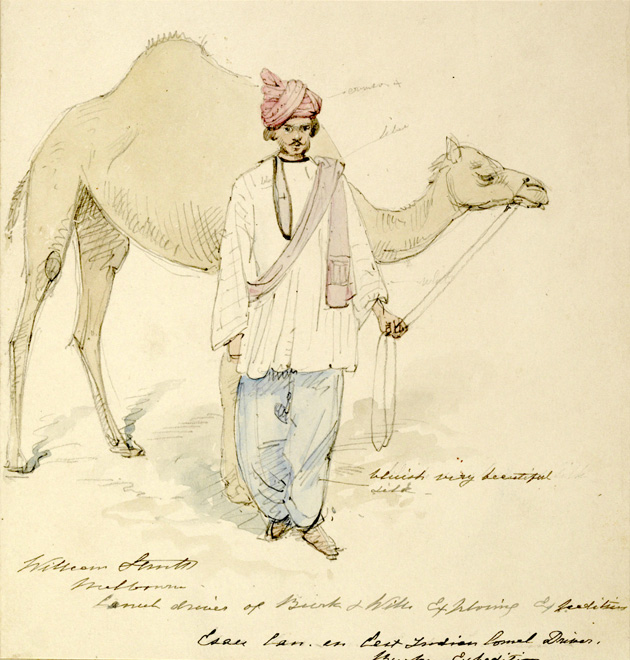
Courtesy of the Dixson Library, State Library of NSW.
Once the camels arrived, Charles took an active role in the detail of their welfare: ‘A separate paddock could be afforded for one of the males that is liable to injure the others; by giving him a few of the females of a similar breed for company, they would probably be the safer and more easily tended’;[24] special provision was made for Nero. Charles also welcomed the prospect of others joining them. ‘There is ample scope on this station for the camels that are with Howitt’s party’, he wrote.
At the Acclimatisation Society meeting in August, the fate of the camels with Howitt on the Relief Expedition was discussed. Howitt had retrieved the bodies of Burke and Wills and was in Menindee when ‘Dr Mueller [was] requested to communicate with the Exploration Committee … that the camels now with Howitt be prevented from leaving the Darling’.[25] Dr Ferdinand von Mueller was a member of both the Exploration Committee of the Royal Society of Victoria, which had organised the Burke and Wills expedition, and the Council of the Acclimatisation Society that had charge of the camels. Mueller was very concerned to keep the camels in Victoria. He volunteered to approach the others of the Exploration Committee to have the camels returned and added to the herd in the Wimmera.[26]
At the next meeting of the Exploration Committee on 22 September 1862, it was noted that a despatch had been received from Howitt at Menindee asking what he should do with the camels. At this meeting, it was suggested that the animals go to Samuel Wilson’s paddock in the Wimmera. Mueller seconded this resolution. He also suggested that Samuel Wilson be ‘informed of the addition which was about to be made to the number of camels in his paddock’.[27] A week later, Samuel Wilson’s letter ‘kindly consenting to take charge of the camels now with Howitt and place them in the paddock with the others’, confirmed the arrangement.[28]
Now that a suitable place had been found for the camels, the Council was keen to bring all of the Victorian Government’s camels together in the Wimmera. At the meeting of 5 August 1862, Mueller volunteered to find ‘McKinlay … to request him to render an official account as to the fate of the four camels he had with him’.[29] John McKinlay had led the South Australian Government’s own Burke Relief Expedition in 1861. Sadly, the camels with McKinlay had been turned loose or killed for food. None remained to come to the Wimmera.[30]
Members of the Council deferred to Mueller on all matters to do with the camels. There were some other camels that ‘turned up’, discarded by Burke on the expedition, and Mueller was keen to bring these under the control of the Council as well. Information concerning a camel at Coonamble, New South Wales and another with Mr Huxley, found near Wellington on 30 May 1865, was addressed to Mueller but he was unsuccessful in acquiring either of them. Huxley gave up waiting for his ’40 pounds for expenses’ and sold the camel with him for ’12 pounds’.[31]
The Condition of the Expedition Camels
The expedition camels had travelled vast distances with Burke, and those that survived at the end of Howitt’s first expedition were in a poor state. ‘Of the thirteen camels here very few are in a fit state to travel, suffering severely from itch’, Edwin Welch wrote in his diary on 6 August 1861.[32] The health of the camels had been poor even before they travelled over 1,500 kilometres to Adelaide with Howitt and then with Aitken to Wilson’s property in the Wimmera. The Argus recorded: ‘Mr. Aitkin, who was detached from Howitt’s exploration party at Adelaide to take the camels to … Mr. Wilson’s station on the Wimmera, arrived … He left Adelaide on the 10th day of December, and arrived at the Wimmera upon the 16th inst. There are now at Mr. Wilson’s, seventeen camels’.[33] A group of school children in Horsham witnessed the arrival. William Candy recalled ‘being let out one day to see camels going through to Walmur. Those camels were the same as used by the Burke and Wills exploring expedition’.[34]
Charles Wilson indirectly commented on the camels’ poor condition when the exhausted animals arrived at Walmer. At the Council meeting on 20 January 1863, ‘A letter was read from Mr. Charles Wilson, reporting the safe arrival of the eight camels from Mr. Howitt’s party … and stating that … it would be desirable to keep them in a paddock apart from the others, which Mr. Wilson kindly promises to have done’.[35] Charles quarantined them, protecting the earlier arrivals from any infectious diseases carried by those that had just arrived from Howitt’s expeditions. He wrote to the Council to tell them too of the ‘death of one of the animals which had returned from Mr. Howitt’s party the animal having been in a very feeble state and nearly blind ever since it arrived at the Wimmera’.[36]
Esau Khan was at Walmer when the eight weary camels with Alexander Aitken limped in. The poor condition of the camels was too much for Khan alone to manage. In a letter to Charles, dated 21 January 1863, the Council offered the services of Belooche, the sepoy on Burke’s expedition.[37] Charles accepted the offer and Belooche’s wages were confirmed three months later: ‘enclosed an account of £13 being Belooche’s wages for one quarter’.[38] Thus Belooche was engaged at about £1 per week soon after the camels arrived, to support Esau Khan.
As noted above, the agistment of the camels at the properties of the Wilson brothers provided savings to the Acclimatisation Society. ‘The cost of the rations of attendants need not be mentioned by the Society’, Charles Wilson had written.[39] The society did not need to pay for the accommodation of Esau Khan or Belooche or for the agistment of the camels but it was expected to supply the wages of the two sepoys.

Courtesy of the Dixson Library, State Library of NSW.
Restoring the Camels to Good Health
The sepoys expressed their concern about the condition of the camels and made several requests to the Acclimatisation Society for goods to assist with their recuperation. In November 1862 Esau Khan asked for oil for the camels that had come from Royal Park; oil was helpful to treat scab.[40] However, his request was refused. Similarly, when the other camels arrived with Aitken, ‘Esau Khan’s opinion was that the camels required wheat and that some of them would require covering for the winter’, but the Council’s view was that ‘No wheat is required … and that in such a climate no artificial covering needs to be provided’.[41]
Towards the end of the year, Esau Khan again requested wheat to build the camels’ strength for the coming winter.[42] At first he was unsuccessful, but ’10 gallons of oil for the camels’ was sent by train to Ballarat a couple of months later,[43] and again in June 1864.[44] This indicates that some of the camels were still recovering. However the fledgling society did not want additional expenses. The reply to Esau’s request for wheat and oil for the camels was tainted by prejudice and the suspicion that ‘Esau only wanted a trip to Melbourne … Mr. Landells [stated] … these black fellows want very strict management’.[45]
Wages were a topic that often appeared in the letters between Charles Wilson and the Council. The sepoys were discontented with their pay of a little over £1 per week. They would make a request for a rise in pay and Charles Wilson would forward the request to the Council. Esau Khan asked for a raise in November 1863 but ‘the Council decided not to increase the wages of Esau at present’.[46] A month later, Esau Khan was reported to be ‘content to remain at his present rate of wages’, but in January 1864 he ‘had again applied for an increase in wages’.[47] By 19 January 1864 ‘Esau wished to be relieved of his charge’. Belooche had already left. He had arrived by February but was gone by September 1863 – a period of eight months.[48] Esau Khan had arrived in September 1862 and left in March 1864 – a stay of eighteen months.
In January 1864, the Council asked Charles Wilson ‘if there were any person in his employ to whom he could confide the care of these animals’.[49] Two weeks later, on 2 February, Charles announced ‘that a man named Barnes has an affinity for the camels and takes charge of them’, and in March he wrote ‘that one of his men was getting on very well with the camels and would he thought be ultimately able to manage them’.[50] When he offered the position to Barnes, Charles reported to the Council that ‘Barnes felt himself equal to taking charge of the camels’, they ‘were delighted with Barnes’ and ‘Esau could be dispensed with’.[51] Barnes took charge of the enlarged herd of camels in the Wimmera from February 1864 until July 1865 – a period of seventeen months.
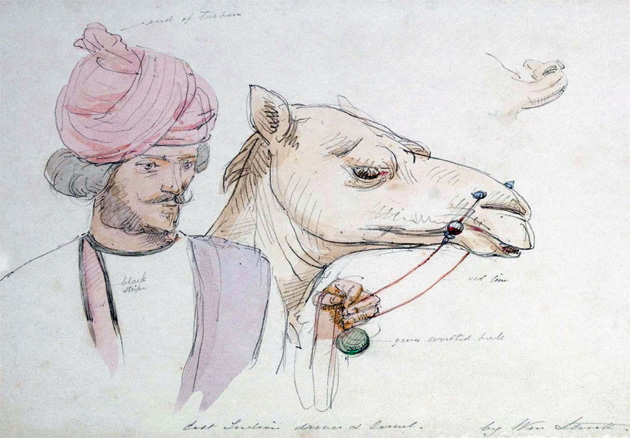
Courtesy of the Dixson Library, State Library of NSW.
The Council monitored its valuable animals carefully even if it rejected most of the requests for expenditure. Charles was asked not only to give the Council an account of how many camels had foals, their sexes and breed, but also ‘the council hoped that a correct register was being kept of the ages of the camel foals’.[52] It also requested the branding of the camels, including the young ones.[53] This was done and the brand was drawn as a triangle with the letters ASV inside the triangle.[54] The camels recovered their health and thus reduced calls on the purse of the Acclimatisation Society for oil and wheat.
Problems Arise at Longerenong Station
On 13 August 1862, before the camels arrived, the Wilson brothers sought permission for the fencing of Longerenong – a wire fence, a novelty in the district and necessary not just for sheep but also for camels. ‘The Wilsons could afford to do things with more polish, and their five wire fences criss-crossing the Horsham plains became famous’.[55] ‘The manager, Mr. Weir, who at one time managed Longerenong Station for [Sir] Samuel Wilson, spoke of camels arriving there and the result was panic amongst the horses, who rushed and broke fences in a mad stampede, and he was left with nothing but the stable hack, nearly mad with terror in a loose box’.[56] The stables had twenty-four horses at the time, including the Cobb and Co horses at the Longerenong Homestead changeover.
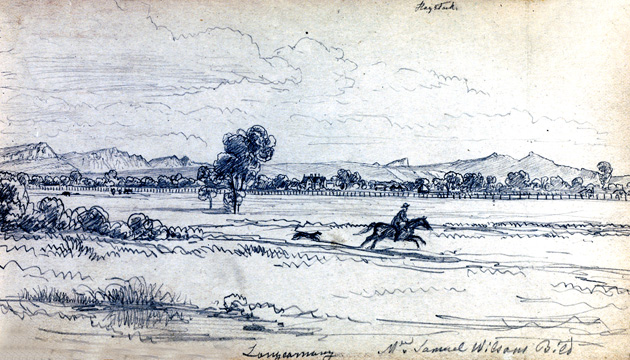
Courtesy of the Dixson Galleries, State Library of NSW.
The manager of Longerenong Station did not appreciate the camels’ ability to scatter horses and to break the only wire fences in the district. This aversion to the camels by the working horses made the camels difficult to use, reducing their usefulness to the Wilsons. Charles Wilson ‘feared the camels would have to be removed in consequence of the many horses taking fright at them’.[57] Some time later, Weir ‘insisted on the camels going to Vectis, Alexander Wilson’s station’.[58]
When the camels arrived in the Wimmera, there were lush pastures, abundant rainfall and brimming rivers. The camels prospered and multiplied. ‘A foal was born in August and another in September of 1863 and another six by December.’[59] The camel herd was growing. Seventeen camels had been brought to the district and eight foals were born, making a total of twenty-five camels.
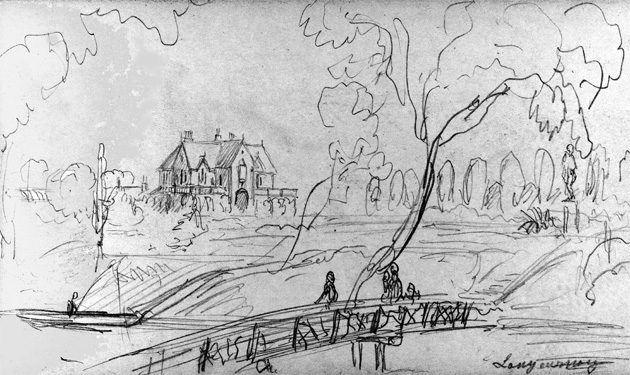
Courtesy of the Dixson Galleries, State Library of NSW.
Not all of the camels survived, however. One camel died from the rigours of the expeditions, arriving feeble and almost blind; another two also died. Nonetheless, on 28 April 1863 Charles notified the Council that ‘the camels were doing well’.[60] Certainly the camels’ humps were full; however if a camel’s hump is full and heavy, it tends to overbalance. Camels’ slippery footpads do not permit them to get a good grip on clay banks, and so they can get bogged, or drown. They are also difficult to lift out of the mud and camels are not built for swimming.
The river crossings were made more difficult in June 1863 by the heavy rains that burst river banks;[61] ‘800-900 sheep were swept down the Wimmera [River]’ in the flood.[62] Charles notified the Council ‘that one of the male Egyptian camels had been drowned in attempting to cross a river’.[63] The Egyptian reference suggests that it was one of Coppin’s camels from Aden, Egypt, which were reported to have ‘bad habits’, were undersized, older and more difficult to handle.[64]
Drought Arrives in the Wimmera
As the camels recovered, they were said to be useful on the properties ‘as beasts of burden’,[65] but the size of the herd was now twenty-one. It was also the beginning of a drought. The year 1865 ‘was a very dry season … equally as bad as the 1902 drought … and so severe that sheep were dying in hundreds’.[66] In August 1864, Charles Wilson first suggested to the Council ‘that in consequence of the want of suitable pasture he should be glad to be released of the charge of the camels early in the ensuing year’[67] but the Council decided to leave this request and ‘bring it forward at another time’.[68] The old question of what to do with the camels had re-emerged. The Acclimatisation Society had nowhere to keep them, as Royal Park was full, with ostriches and alpacas arriving imminently. The food bill for the camels would have been high, and there was no current task for them. Their future continued to be debated by the Council until October 1865.
In January 1865, Charles wrote to the Council ‘announcing the death of a female camel’. In reply, the Council noted this news briefly and explained the reason for their communication, which was the intended dispersal of some of the camels to the South Australian Government.[69] By now the Council was more interested in giving the camels away than news of their survival.
Later Expeditions
After receiving the request from Charles Wilson to remove the camels, the Council had to decide what to do with them. Some of the solutions proposed by Council members were creative: ‘write to Dr. Mueller and ask whether … to allow these animals to be located at one of the Police stations’.[70] In fact, the Council had already decided to send four pairs to ‘Mr. Panton’s Pastoral Company and the remainder on terms to … the South Australian Government’.[71] Within seven months, however, Mueller would launch a new expedition, disappoint two wealthy pastoralists, persuade the Council to make all of the camels available to the new expedition, and disappoint the South Australian Government later in May.[72]. By July 1865 a letter from Charles Wilson to Council confirmed the arrangement: ‘fourteen camels had been delivered over to the Leichardt Search party’.[73]
Even Mueller could not persuade the Council to keep the remaining herd for other expeditions. He was absent from the meeting of the Acclimatisation Society on 10 October 1865 at which ‘a letter was read from Mr JA Panton offering the sum of 50 pounds [each] for the purchase of the camels now in the Wimmera … to become the absolute property of Mr. Panton’.[74] The Council acted decisively and sold the camels. It did not require any debate on the matter, and the topic was not referred to the agenda of the next meeting. Instead, the camels were sold to Mr Panton ‘to go to the northern districts’ to ‘pastoral holdings between the Murray and Menindee’.[75] Mueller was very disappointed. At the next meeting he ‘directed the Secretary to record in the minutes: “Dr Mueller expressed his regret that the camels had been disposed of on the terms stated … and that he had been prevented to record his dissent by no notice of the final disposal of these animals having appeared in the notice paper”.’[76]
Camels were still reported at Longerenong until Samuel Wilson sold the station in 1874. There was also a story that ‘A camel that had been left by Burke on the north bank of the Murray River fourteen years before was captured on Murray Downs Station and taken to Longerenong’.[77]
Duncan McIntyre led the Ladies’ Leichardt Expedition of 1865 organised by Dr Mueller. On the published list of members of the expedition were Belooche, the Indian camel driver, and John Barnes, who had taken over the care of the camels on the Wilsons’ property.[78] Sadly, by this time there were only twelve camels remaining.[79] Duncan McIntyre died of Gulf fever on 4 June 1866, leaving the camels at Dalgonelly Station.
Conclusion
When Burke and Wills’s state funeral was underway in Melbourne on 23 January 1863, the pastures of the Wimmera were restoring the surviving camels to health. They were valuable animals and were not abandoned after Burke’s and Howitt’s expeditions. Many returned to the Riverina and Menindee on Panton’s pastoral holdings, while fourteen others left on the Leichardt Expedition. But their fate, and that of their sepoys, is another story.
Endnotes
[1] PROV, VA 3123 Royal Zoological and Acclimatisation Society, VPRS 2223/P0, Unit 1, Minute Book 1 1861-1863, 7 May 1861.
[2] PROV, VA 3123, VPRS 2225/P0, Unit 1, Letter Books Outwards 1862, 14 May 1862, p. 116.
[3] Argus, 13 March 1862, p. 4g.
[4] The issue was raised again at a meeting a month later. See PROV, VPRS 2223/P0, Unit 1, Minute Book, 5 August 1862.
[5] ibid.
[6] ibid., 12 August 1862.
[7] EJ Welch, ‘Journal of Victorian Exploring Party, 1861-1862’, State Library of Victoria, MS 13071, Box 2087/7, Item (a). Welch was surveyor on Howitt’s relief expeditions.
[8] PROV, VPRS 2223/PO, Unit 1, Minute Book, 5 August 1862.
[9] ibid., 30 September 1862.
[10] R Kingston, Good country for a grant: a history of the Stawell Shire, Shire of Stawell, 1989, p. 131.
[11] Thomas Young in Dennys, Lascelles Ltd., Annual, 1926, p. 55.
[12] Argus, 16 October 1862, p. 4g.
[13] PROV, VA 3123, VPRS 8850/P1, Unit 227, Acclimatisation Society Annual Report, 1862-1863.
[14] PROV, VPRS 2223/P0, Unit 1, Minute Book, 7 July 1863.
[15] Australasian, 27 January 1877.
[16] Argus, 13 September 1862, p. 5e.
[17] PROV, VA 3123, VPRS 2225/P0, Unit 1, Letter Books Outwards 1862, 1 September 1862, p. 445.
[18] PROV, VPRS 2223/P0, Unit 1, Minute Book, 5 August 1862.
[19] Ballarat star, 22 September 1862.
[20] ibid.
[21] PROV, VPRS 2225/P0, Unit 1, Letter Books Outwards, 6 August 1862, p. 363.
[22] Argus, 11 June 1860, p. 4b.
[23] Argus, 16 October 1862, p. 4g.
[24] ibid.
[25] PROV, VPRS 2223/P0, Unit 1, Minute Book, 5 August 1862.
[26] Argus, 23 September 1862, p. 5a.
[27] ibid.
[28] PROV, VPRS 2225/P0, Unit 1, Letter Books Outwards, 30 September 1862, p. 487.
[29] PROV, VPRS 2223/P0, Unit 1, Minute Book, 5 August 1862.
[30] See ‘McKinlay’s Camels’, Burke and Wills Web, available at <http://www.burkeandwills.net.au/Camels/Mckinlays_Camels.htm>, accessed 22 October 2010
[31] PROV, VPRS 2223/P0, Unit 3, Minute Book, 29 August 1865.
[32] Welch, ‘Journal’.
[33] Argus, 20 January 1863, p. 5b.
[34] W Candy, Reminiscences of the early Mallee and Wimmera, Warracknabeal Herald Print, 1927, p. 2.
[35] Argus, 22 January 1863, p. 5b.
[36] PROV, VPRS 2223/P0, Unit 1, Minute Book, 10 February 1863.
[37] PROV, VPRS 2225/P0, Unit 2, Letter Books Outwards, p. 537.
[38] ibid., 20 April 1863, p. 537.
[39] Argus, 16 October 1862, p. 4g.
[40] PROV, VPRS 2225/P0, Unit 2, Letter Books Outwards, 5 November 1862, p. 61.
[41] ibid., 11 February 1863, p. 334.
[42] ibid., 5 November 1863, p. 61.
[43] PROV, VPRS 2225/PO, Unit 3, Letter Books Outwards 1863-1864, 4 January 1864, p. 400.
[44] ibid., 29 June 1864, p. 663.
[45] PROV, VPRS 2225/P0, Unit 2, Letter Books Outwards, 11 February 1863, p. 334.
[46] PROV, VPRS 2223/P0, Unit 3, Minute Book, 17 November 1863.
[47] ibid., 29 December 1863, 5 January 1864.
[48] ibid., 19 January 1864.
[49] ibid.
[50] ibid., 3 March 1864.
[51] PROV, VPRS 2225/P0, Unit 3, Letter Books Outwards, 23 March 1864, p. 521.
[52] ibid., 6 January 1864, p. 390.
[53] ibid.
[54] ibid., 23 March 1864, p. 482.
[55] S Priestley, Warracknabeal; a Wimmera centenary, Jacaranda Press, Brisbane, 1967, p. 20.
[56] T Young, Pioneer station owners of the Wimmera, T Young, Horsham, Victoria, 1926, p. 56.
[57] PROV, VPRS 2223/P0, Unit 3, Minute Book, 17 November 1863.
[58] ibid.
[59] PROV, VPRS 2223/P0, Unit 1, Minute Book, 23 December 1863.
[60] ibid., 28 April 1863.
[61] CE Sayers, Shepherd’s gold: the story of Stawell, FW Cheshire Pty Ltd, Melbourne, 1966.
[62] Ararat advertiser, 5 June 1863.
[63] PROV, VPRS 2223/P0, Unit 3, Minute Book, 1 September 1863.
[64] Argus, 25 July 1860, Supplement, p. 4b.
[65] PROV, VPRS 2225/P0, Unit 4, Letter Books Outwards 1864-1868, 23 March 1864, p. 521.
[66] Candy, Reminiscences.
[67] PROV, VPRS 2225/P0, Unit 4, Letter Books Outwards, 18 August 1864, p. 743.
[68] PROV, VPRS 2223/P0, Unit 3, Minute Book No. 2, 16 August 1864, pp. 550-551.
[69] PROV, VPRS 2225/P0, Unit 4, Letter Books Outwards 1864-1868, 19 January 1865, p. 207.
[70] PROV, VPRS 2223/P0, Unit 3, Minute Book No. 2, 31 January 1865.
[71] ibid., 20 December 1864.
[72] ibid.,10 January 1865, 21 March 1876, 2 May 1865, 30 May 1865.
[73] ibid., Minute Book, 18 July 1865.
[74] ibid., 10 October 1865.
[75] ibid.
[76] ibid., 17 October 1865.
[77] C Lever, They dined on eland: the story of the acclimatisation societies, Quiller Press, London, 1992, p. 330.
[78] Argus, 31 May 1866, p. 7c.
[79] ibid.
Material in the Public Record Office Victoria archival collection contains words and descriptions that reflect attitudes and government policies at different times which may be insensitive and upsetting
Aboriginal and Torres Strait Islander Peoples should be aware the collection and website may contain images, voices and names of deceased persons.
PROV provides advice to researchers wishing to access, publish or re-use records about Aboriginal Peoples
